This month, for our ongoing discussion of making mistakes in the estimating process, we'll take an in-depth look at one of the most common venues interpretive logic.
At the most basic level, the most important and fundamental attribute for a person engaged in the profession of estimating is the ability to read design drawings expertly-relevant to your trade's work. For us in the walls and ceilings industry, this means, for the most part, the architectural drawings. You must know how a section relates to a plan, a detail to a section, etc. Interpreting design drawings is the foundation upon which all else is dependent in the estimating process. We must also be familiar with the interpretation, nuances, format, etc., of the other categories of design drawings/delineations for work relevant to our trade's work. This includes:
o Structural
o Mechanical
o Electrical
o Plumbing
o HVAC
As well, all the sub-categories of each of the above such as: demolition, fire protection, lighting ,etc.
Since reading drawings expertly is, after all, an acquired skill, experience is the best teacher. I studied architecture in college but went in knowing how to read plans from my experience as a child making model airplanes and boats. The assembly instruction sheets contained all the elements of a set of design drawings:
o Plans
o Elevations
o Sections
o Details
o Schedules
When I found myself as a Junior Estimator after graduating college, I came to realize that the pieces were different (and more complex) but essentially, the puzzle was the same for a model B-17 as it is for a skyscraper. Since the skill level of each individual estimator (as it pertains to drawing interpretation) can and does vary widely, it is perhaps the most fertile ground for estimating mistakes taken in the form of misinterpreted logic.

The eye of the beholder
The figure shows an exterior wall section for a high-rise building. For the purpose of this example, let's define our scope of work as follows:Furnish and install the "Drywall Closure" at the window head condition below the pre-cast concrete spandrel panel for (100) LF/FLR on the floor/s where it occurs.
The section indicates Floors 24 through 31 for the floors where the section occurs. By applying the standard formula for determining the number of floors (assuming sequential numbering):
(Floor High - Floor Low) + 1
We can determine the number of floors below the pre-cast spandrel panel easily:
(Floor 30 - Floor 24) + 1 = 7 Floors
At first glance, it appears that the Drywall Closure occurs at these seven floors. A closer examination reveals that the pre-cast spandrel panel occurs only at the 31st Floor level. Recall the scope of work-the Closure only is required below the spandrel panel. Thus, being that the spandrel panel only occurs at the 31st Floor, it is logical to surmise/establish that the Drywall Closure will only occur at the 30th Floor window head-not for Floors 24 through 30.
The window head condition for floors 24 through 29 will be exactly as it is indicated for the floor/s below 24 through 30-attached directly to the underside of the concrete floor slab. For this condition, no Drywall Closure is required. Think about this for a minute. If the estimator had not interpreted this detail correctly-that is, occurring at the 30th Floor only (1 FLR x 100 LF/FLR = 100 LF), rather than for Floors 24 through 30 (7 FLRS x 100 LF/FLR = 700 LF) a quantitative overestimate of (600) LF (700 LF - 100 LF) would have occurred.
The great German Architect Ludwig Mies Van Der Rohe was famous for his observation: "God is in the details." He was right. As this simple example illustrates-for the estimator in particular-God is not only in the details but also in the interpretation of the details. Next month, we'll continue our ongoing discussion of making mistakes in the estimating process.W&C



Report Abusive Comment